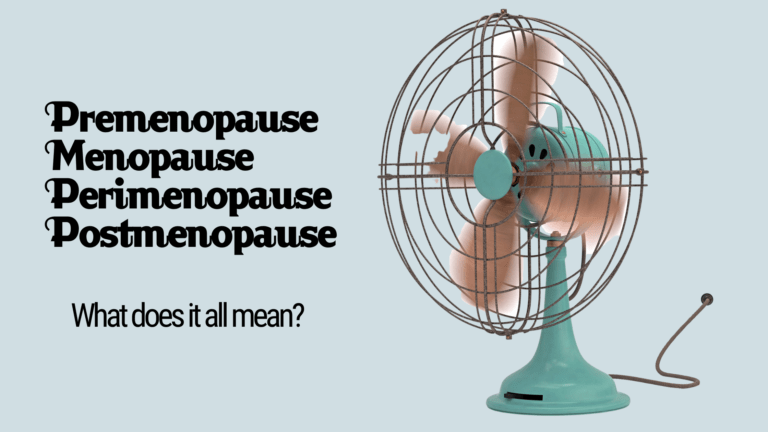Premenopause, Menopause, Perimenopause, Postmenopause
Do you know the difference?

What is menopause? Every woman goes through it. Yet, it rarely comes up in discussion, and even fewer people know what it is or how to help women cope with it. And then you throw in the terms premenopause, perimenopause, and postmenopause, and people are lost! If you are feeling confused, read on to clear the clutter.
Generally speaking
All of the terms above represent a life stage for women. The difference in stages is associated with the two primary hormones, estrogen and progesterone. These hormones affect all parts of our body, including muscular and brain health, bone growth, and metabolic functions. I just learned from a menopause conference that estrogen has receptors all over the body. Hence, there are 34 symptoms associated with perimenopause and menopause. Because there are so many estrogen receptors, symptoms such as hot flashes, night sweats, and weight gain occur when estrogen levels change erratically.
Furthermore, estrogen and progesterone tend to have opposing effects on each other. When they are no longer in balance during a regular monthly cycle, the contrasting effects can exacerbate symptoms of perimenopause and menopause. First, let’s touch briefly on the variety of roles estrogen and progesterone play in the body.
Estrogen
Estrogen comes in 3 different forms, but the primary one I will refer to is E2. From now on, I will refer to E2 as simply estrogen. Below are some of the most significant effects it has on the body:
- Muscles: estrogen is involved in glucose homeostasis within muscles cells and improves muscular strength
- Brain: estrogen has a role in serotonin production, appetite regulation, and thermoregulation
- Bone: it increases calcium absorption and therefore has a protective effect on maintaining bone strength and structure.
- Metabolism: estrogen helps to regulate glucose levels, appetite hormones, and aid in the release of fatty acids for energy which is helpful for weight loss
Progesterone
Alternatively, progesterone has opposing effects compared to estrogen.
- Muscles: estrogen inhibits muscle protein synthesis and decreases the strength of tendons and ligaments
- Brain: progesterone increases pain tolerance
- Bone: it decreases the rate of calcium excretion, hence promoting stronger bones
- Metabolism: it has a hand in increasing respiration, heart rate, and core temperature (hot flashes anyone!!) and works as an anti-inflammatory steroid.
So, with the general functions of the hormones done, let’s look at the difference between these life stages and how hormones can affect them.
Premenopause
Premenopause refers to ‘the reproductive years.
- Typically starts at age 12-13, upon the start of the first period, and continues 30-40 years until the mid-forties
- Hormone levels fluctuate monthly with menstruation and are somewhat predictable with periods
- Symptoms are mild and include bloating, fatigue, headaches, and irritability
- Nutrition and fitness can modulate the symptoms associated with your monthly period
Perimenopause
- Typically starts between the ages of 46-48 and can last anywhere between 5-10 years
- Hormones can fluctuate wildly with no predictability. Periods begin to become irregular (if they weren’t already!)
- Common symptoms include hot flashes, night sweats, brain fog, sudden weight gain, decreased bone health, and insomnia
- A weight gain of 5-8 pounds is very common, and many women experience more
- Nutrition and fitness strategies can significantly reduce mild to moderate symptoms associated with perimenopause.
Menopause
- Typically starts at age 51 but can vary between 45-55 years of age.
- Point in time where menses stops altogether for 12 months and follows perimenopause.
- Hormone fluctuations start to decrease compared to perimenopause but do still exist
- The severity of symptoms such as hot flashes and night sweats may begin to decline, and weight may start to stabilize (though usually not at the same premenopause weight)
- Nutrition and fitness strategies can reduce the symptoms of menopause; however, they do not have as significant an effect as during perimenopause.
Postmenopause
- Stage immediately after menopause and typically doesn’t change significantly for the rest of life
- Hormone fluctuations are small and may not be present at all
- Symptoms such as hot flashes, night sweats, and others associated with perimenopause and menopause may still occur but with decreased severity, despite the lack of hormone fluctuations
- Nutrition and fitness strategies can help to decrease mild to moderate symptoms of postmenopause.
Summary
Estrogen and progesterone, while they work in opposing forces, tend to balance each other out during the premenopause stage of life. It is during perimenopause and menopause when estrogen and progesterone fluctuations become erratic. Due to the changes in hormones that occur in perimenopause and menopause, symptoms begin to appear. However, all is not lost. Changing your nutrition and fitness strategies can help navigate this time of life and let you re-gain (somewhat control) what is happening to you. As an example, check out my blog on how to change your exercise routine to see results.
If symptoms become severe enough to disrupt your daily life, nutrition and fitness can still help. However, it may be time to talk with your doctor about menopausal hormone therapy (MHT) and the best course of action to take for you. The North American Menopause Society is a great place to learn more about perimenopause and menopause or find a doctor specializing in menopause.
